us toll free: 1-800-948-5563 international: +1 (843) 849-0283 UK: +44 (0) 1334 260018
"The most popular and perhaps best writer in Spanish since Cervantes." - Carlos Fuentes
Gabriel García Márquez, March 6, 1927 - April 17, 2014, was one of the 20th century’s leading authors. The earliest living recipient of the Nobel Prize in Literature, García Márquez is best known for his novels, One Hundred Years of Solitude (1967), Autumn of the Patriarch (1975), and Love in the Time of Cholera (1985). García Márquez spent the first eight years of his life under the guardianship of his maternal grandparents; it was their stories that fueled his imagination and influenced his work later in life. García Márquez is the master of magical realism, a technique in which writers incorporate the supernatural into the mundane. His stories defy traditional depictions of reality, instead “the most frightful, the most unusual things are told with the deadpan expression.” Read More
Margaret Eustella Fau: Gabriel García Márquez; Annotated Bibliography and Bibliographic Guide
Fau's reference bibliographies of the works of Nobel Prize winner Gabriel García Márquez; an annotated bibliography of books and articles on the career and works as well as annotated dissertations, bibliographies, interviews, books about García Márquez, critical articles from scholarly journals and reviews.
Gene H. Bell-Villada: García Márquez; The Man And His Work
Bell-Villada traces the major forces that have shaped the Columbian novelist and Nobel Prize winner and describes his life, his personality, and his political opinions.
The fight between Mario Vargas Llosa and Gabriel García Márquez is very intriguing and differs greatly from the rest of our famous literary brawls in that their fight was both physical and personal. At one time, these Nobel Prize winners were the best of friends. However, after Llosa separated from his wife to be with a Swedish flight attendant, Llosa’s wife sought comfort from his good friend, García Márquez.
Outside of a theatre in Mexico City, Llosa rushed up to García Márquez who opened his arms to embrace his dear friend, who promptly returned the outstretched arms with a swift slug to García Márquez’s eye.The two have never made a public statement confirming what actually happened that day, nor have they spoken to each other since the incident.
García Márquez became intimately familiar with Colombia's history thanks to his maternal grandfather. Colonel Nicolás Ricardo Márquez Mejía was a veteran of the War of a Thousand Days and a founder of his grandson's hometown of Aracataca. He'd refused to stay silent about the banana strike massacre, denouncing Congress for the government's behavior in 1929.
The Colonel had led quite an interesting life. He'd killed a man in a duel andhad reportedly fathered 16 children. He taught young Gabriel lessons from the dictionary and took him to see ice for the first time--an encounter that would inspire an episode in One Hundred Years of Solitude. Meanwhile, his wife, Tranquilina Iguarán Cotes, filled her grandson's head with superstitions and ghost stories. Her storytelling style would influence García Márquez's own narrative style as he got older. He once observed, "I feel that all my writing has been about the experiences of the time I spent with my grandparents."
Young Gabriel spent his formative years with his grandparents. His mother, Luisa Santiago Márquez, fell desperately in love with his father, Gabriel Eligo García against the wishes of the Colonel and Tranquilina. Eligo García was a hojarasca ("dead leaf"), a newcomer attracted to the town by the banana industry. He had four illegitimate children already. The Colonel and his wife tried everything they could think of to dissuade the young couple, but to no avail. They married and settled in nearby Riohacha. >>Read More
Clandestine in Chile |
Love in the Time of Cholera |
Of Love and Other Demons |
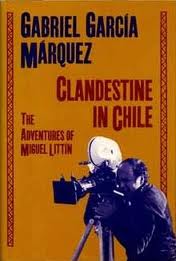 |
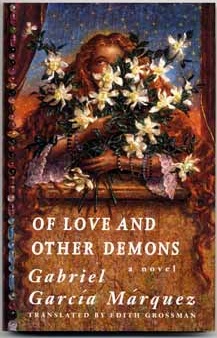 |
|
|
Though García Márquez is best known for his epic novels and magical realism, he's always woven history and politics into his stories. With Clandestine in Chile: The Adventures of Miguel Littin (1986), García Márquez offers a much more direct look at the politics of Latin America. Famous film director Miguel Littin was exiled after the assassination of Chilean President Salvador Allende. He returned incognito twelve years later to document life under the Augusto Pinochet regime. After meeting Littin in Madrid in 1986, García Márquez wrote this account of the Littin's filming.
|
Published in 1985, García Márquez's fourth novel, Love in the Time of Cholera, explores the nature of love and its various manifestations. Over the course of fifty years, characters Florentino Ariza and Fermina Daza fall into and out of love. Passionately attached in their youth, Fermina's father separates the two when he learns of their secret engagement. Fermina soon forgets her feelings for Florentino and marries a wealthy doctor. Yet after decades apart, Fermina's husband dies and Florentino attends the funeral. Can their relationship be renewed? |
Inspired by a tale told by his grandmother, García Márquez’s novel, Of Love and Other Demons, explores the boundaries between reality and fantasy. The story of a young girl bitten by a rabid dog, her strange behavior is explained variously as rabies, demonic possession, and insanity. The priest sent to investigate becomes infatuated with the girl and their relationship leads to tragic consequences. A book about the nature of truth and the force of love, its mysterious events defy science, faith, and superstition.
|
News of a Kidnapping |
Living to Tell the Tale |
The Story of a Shipwrecked Sailor |
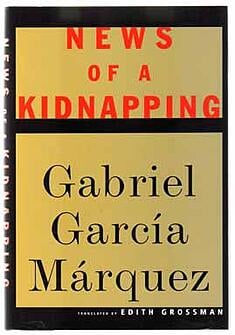 |
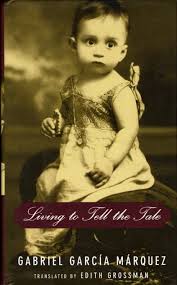 |
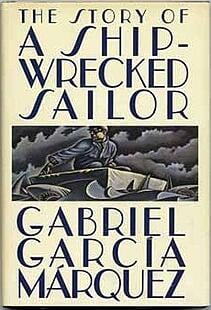 |
|
In the 1980’s, Columbia and the United States made an extradition treaty in an effort to curb the international drug trade. Fearful that the agreement would compromise their business and lead to imprisonment, the Medellín drug cartel—led by Pablo Escobar—kidnapped ten prominent Columbian citizens to pressure the Columbian government into breaking the agreement. García Márquez chronicles the harrowing fate of these hostages and the ultimate resolution of the crisis in his non-fiction account, News of a Kidnapping.
|
The first volume in a planned trilogy, García Márquez’s autobiography, Living to Tell the Tale, is a lyrical account of his early life and young adulthood. Rooted between the principal women in his life—his wife and his mother—the book flows back and forth in time from his childhood, family life, and early career. He includes real-life episodes that inspired his fiction, including the Banana massacre from One Hundred Years of Solitude. The book concludes romantically with his engagement to his wife; the second volume will describe his career as a novelist. | This is "the story of a shipwrecked sailor who drifted on a life raft for ten days without food or water, was proclaimed a national hero, kissed by beauty queens, made rich through publicity, and then spurned by the government and forgotten for all time." (from the title page). First published as a series of stories in El Espectador, García Márquez originally wrote this exposé in 1955. This story led to the first of many exiles for García Márquez when the newspaper, fearing violent repercussions from the scandal, sent him to Rome as a foreign correspondent. |